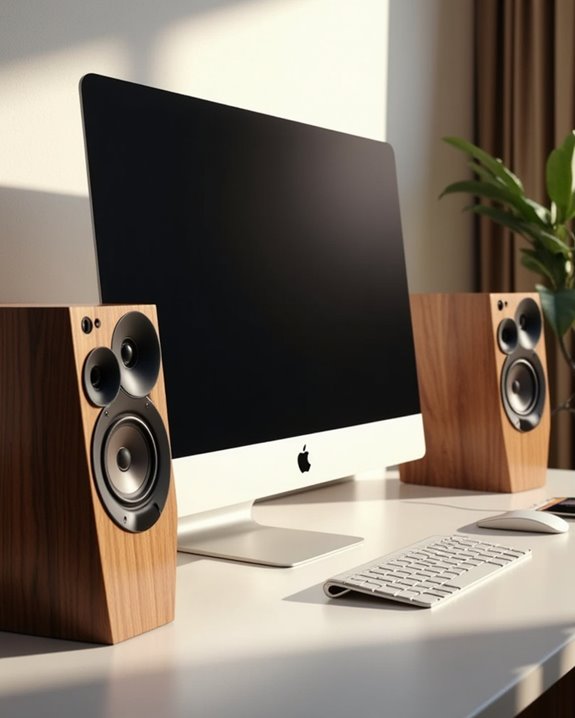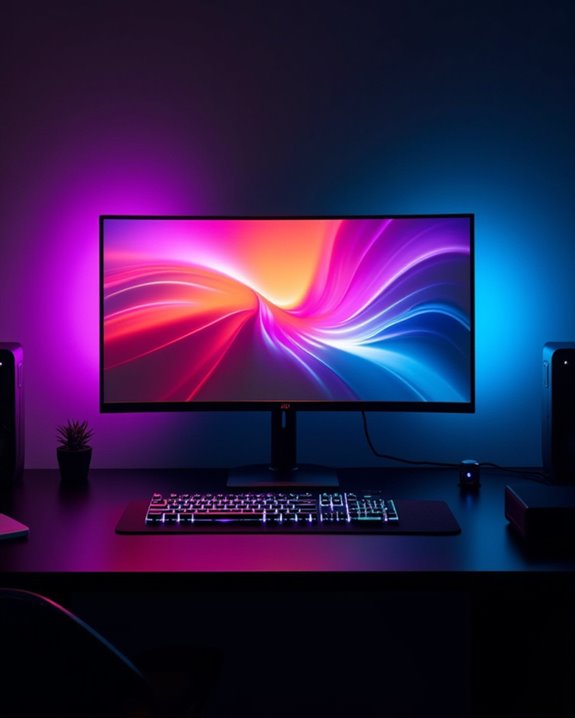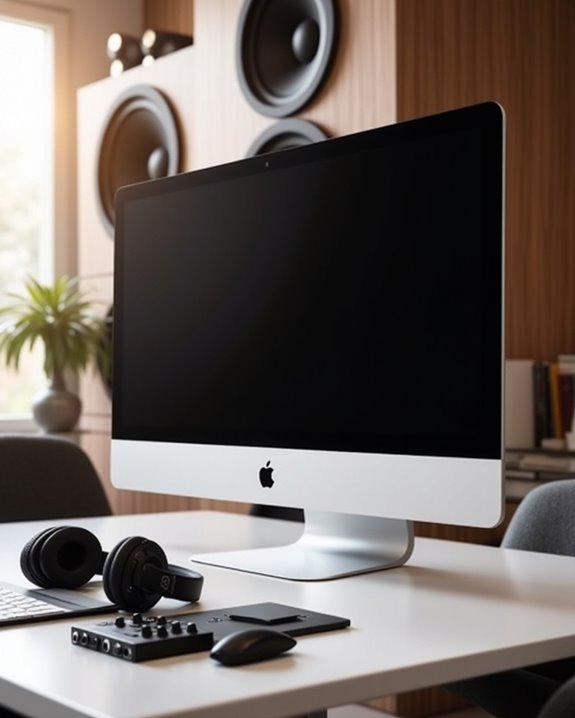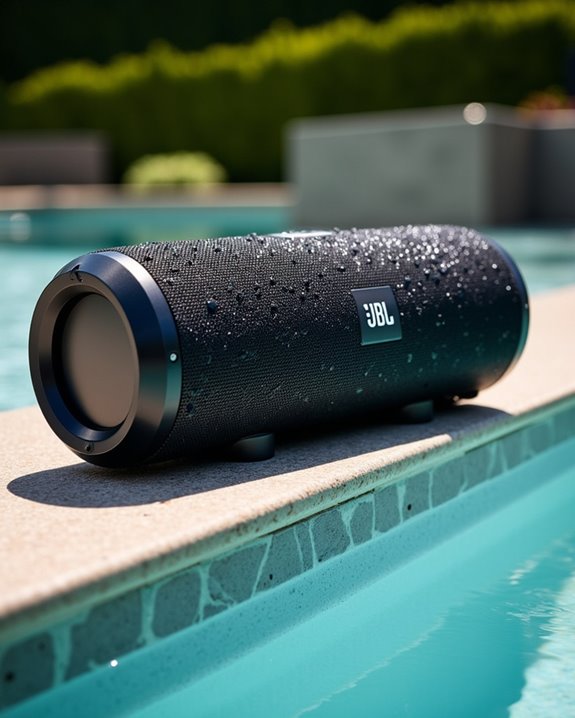Some monitors include built-in speakers while others do not. Budget and mid-range displays often omit speakers to reduce costs, whereas productivity-focused 4K/5K models integrate them for space efficiency. Professional-grade monitors typically feature dual 3W-5W speakers alongside their visual capabilities. Gaming monitors may include enhanced audio systems with 2.1 configurations and specialized audio presets. Manufacturers clearly indicate audio features in product specifications through wattage ratings (2-5W) and visible speaker grills. The following sections explore audio quality expectations and alternative solutions.
Key Takeaways
- Some monitors have built-in speakers, while others don’t—it depends on the model and intended use.
- Budget and mid-range monitors often omit speakers to reduce costs, while productivity and professional models typically include them.
- Built-in monitor speakers typically range from 2W to 5W in power, offering basic audio suitable for everyday tasks.
- Monitors with speakers can be identified by product specifications, speaker grills on the display, or explicit audio wattage ratings.
- External speakers or headphones remain popular alternatives for those seeking better audio quality than built-in monitor speakers provide.
The State of Built-in Speakers in Modern Monitors
The integration of speakers in modern monitors varies greatly across market segments, with manufacturers making strategic decisions based on intended use cases and price points. Most budget and mid-range options omit speakers as a cost-cutting measure, while professional-grade displays increasingly feature dual 3W-5W speakers alongside color-critical capabilities. The Historical Development shows a clear division: productivity-focused 4K/5K models commonly incorporate speakers for space efficiency, whereas gaming monitors prioritize panel specifications over audio quality.
Future Trends indicate growing inclusion of speakers in home-office models driven by remote work demands, while Thunderbolt 4 adoption standardizes audio integration in prosumer displays. High-end creative monitors balance multimedia needs with professional calibration, typically including basic speakers with limited frequency response and higher distortion levels at maximum volume.
How to Identify Monitors With Integrated Speakers

Identifying monitors with integrated speakers begins with examining the product specifications, which typically list audio features in the technical details section. Manufacturers often include designated icons, audio wattage ratings, or explicit mentions of “built-in speakers” in their documentation and marketing materials. Visual inspection for speaker grills or perforations along the monitor’s bezel provides immediate physical confirmation, with these openings usually appearing as symmetrical patterns on the lower edge or rear of the display. Additionally, some monitors designed for media consumption highlight audio capabilities explicitly to appeal to multimedia users integrated sound systems.
SUBHEADING DISCUSSION POINTS
Spotting monitors with built-in speakers requires careful attention to specific design elements and technical specifications, particularly for consumers seeking all-in-one display solutions. When examining monitor models, look for visible speaker grills typically located along the bottom bezel or sides of the display unit. Product specifications often list speaker wattage (generally 2W-5W) and audio technologies such as DTS or Dolby certification.
For proper Blog Formatting, review the Section Titles and product descriptions that explicitly mention “integrated audio” or “built-in speakers” in feature lists. Weight comparison between similar models can also indicate audio hardware inclusion, as speaker-equipped monitors typically weigh 10-15% more than their counterparts. Additionally, price differentials often reflect the added audio components, with integrated-speaker models commanding a premium of approximately $30-50 over comparable speaker-less options.
Check Product Specifications
With careful attention to product specifications, consumers can accurately determine whether a monitor includes built-in speakers before making a purchase. Detailed product listings typically highlight integrated audio capabilities, with manufacturers specifying speaker power ratings (commonly 2W to 5W) and audio connectivity options.
When evaluating monitors, pay close attention to the complete technical specifications section, which lists audio features alongside screen size and panel type. IPS panels, which offer superior color accuracy, are frequently paired with built-in speakers in premium productivity monitors ranging from 23 to 27 inches. Look specifically for:
- “Integrated speakers” or “built-in audio” in feature lists
- Audio input/output port configurations (3.5mm jacks or HDMI with audio support)
- Speaker wattage ratings, which indicate audio performance
- Complementary features like anti-glare finishes and adjustable stands
Look for Speaker Grills
Visual inspection provides one of the most reliable methods for determining whether a monitor contains built-in speakers without consulting documentation. When examining a monitor, look for speaker grills—typically rectangular or oval perforations positioned on the bottom edge or sides of the display. Modern Grill Trends favor minimalist designs with micro-perforations that protect drivers while maintaining acoustic transparency.
The Material Effects of grills greatly impact both performance and aesthetics; metal meshes offer superior protection with minimal sound wave interference, while plastic variants may slightly color the audio profile. Users should also check for accompanying features such as volume control buttons or audio input/output ports near the grills, which confirm speaker integration. The presence of branded badging near these areas, particularly from audio specialists like Polk, further indicates enhanced sound capabilities in the monitor design.
Sound Quality: What to Expect From Monitor Speakers

When evaluating monitor speakers, users should understand the fundamental difference in sound quality compared to standard consumer audio equipment. Monitor speakers are engineered with a flat Frequency Response, typically ranging from 40Hz to 40kHz, which guarantees audio professionals hear an accurate representation of their recordings without artificial coloration.
Unlike consumer speakers that often feature a V-shaped response curve with enhanced bass and treble, monitor speakers deliver a Neutral Sound that prioritizes accuracy over listening pleasure. This uncolored reproduction is critical for creating mixes that translate well across various playback systems. The separation of tweeters (usually 1″) and woofers (5″ to 6.5″) with proper crossover networks enables precise sound reproduction across the frequency spectrum, allowing producers to make informed decisions during mixing and mastering processes.
Popular Monitor Models With Built-In Audio

The gaming sector offers robust speaker integration in models like the LG Ultragear 32GS95UE, which combines its dual-mode capability (4K/240Hz and 1080p/480Hz) with above-average built-in audio performance for immersive gameplay. Budget-conscious shoppers can select from office-oriented options such as the MSI PRO MP243 and ViewSonic VG2448, both featuring built-in speakers that deliver functional audio for everyday productivity tasks without requiring external peripherals. Higher-end solutions like the MSI MPG 321URX QD-OLED generally prioritize visual performance over audio capabilities, though many premium monitors still incorporate basic speakers for convenience while reserving desk space.
Gaming-Ready Audio Solutions
Many gaming monitors now integrate sophisticated speaker systems that eliminate the need for external audio peripherals while delivering immersive sound experiences. This Audio Innovation addresses gamers’ demands for streamlined setups while maintaining competitive audio quality.
Models like Samsung Odyssey G9, Dell S2722QC, and BenQ EW2780Q exemplify Ecosystem Integration through their built-in audio capabilities. The BenQ EW2780Q features 5W treVolo speakers that produce rich sound profiles comparable to entry-level external systems. Gaming-focused monitors balance audio performance with essential gaming specifications, including high refresh rates (up to 240Hz), rapid response times (as low as 0.03ms), and adaptive sync technologies like G-Sync and FreeSync. These integrated solutions offer adjustable sound settings and support external audio connections for users seeking expanded capabilities, making them versatile for both gaming and general entertainment purposes.
Budget-Friendly Speaker Options
While gaming monitors showcase advanced audio innovations, budget-conscious consumers can find significant value in more affordable monitors with integrated speakers. Models like the Dell S2425HS and S2725HS offer practical 5-watt stereo speakers that eliminate the need for external audio systems, providing functionality comparable to basic Car Audio setups for everyday use.
The BenQ Mobius EX2710 Q stands out with its 2.1 sound system, including a built-in subwoofer that delivers enhanced audio clarity at 165Hz refresh rates. This configuration resembles compact Outdoor Systems in its efficient space utilization. For professionals requiring clear conferencing audio, the Dell U2723QE combines 4K resolution with integrated speakers optimized for communication. These budget-friendly options save valuable desk space while delivering adequate sound performance for multimedia consumption, light gaming, and productivity tasks without additional investment.
When Monitor Speakers Make Sense (And When They Don’t)

Choosing when to incorporate monitor speakers into an audio setup requires careful consideration of both technical requirements and practical limitations. Monitor speakers excel in professional environments where accuracy and detailed sound reproduction are paramount, effectively revealing nuances that might be missed with standard speakers despite Environmental Noise factors. Their neutral tonal balance provides extended listening sessions with reduced User Fatigue compared to bass-heavy consumer alternatives. Additionally, modern models often feature advanced aux connectivity options, making them compatible with various devices.
However, these speakers present distinct disadvantages in certain scenarios. Their higher cost, increased weight, and repair complexity make them impractical for casual users. Many smaller monitors lack sufficient bass response, necessitating additional subwoofer investment. For home settings, the aesthetic limitations and technical expertise required for proper placement may outweigh the sonic benefits unless pristine audio reproduction is the primary objective.
Gaming Monitors vs. Office Monitors: Audio Differences

Despite sharing similar display technologies, gaming and office monitors diverge markedly in their audio capabilities, reflecting their distinct use cases and target demographics. Gaming monitors typically include more prominent 2Wx2 speaker systems, often paired with high refresh rates (180Hz) and HDR10 compatibility, while office monitors implement more understated audio solutions focused on meeting functionality.
Design Influence manifests through gaming monitors’ audio presets labeled for specific genres, though their effectiveness remains questionable. Meanwhile, office monitors prioritize speech clarity and uniform volume output to minimize workplace disruption. Environmental Adaptability factors show in office speakers’ longer-rated durability under consistent low-volume use, compared to gaming speakers that struggle with bass reproduction and compression artifacts above 75% volume. Neither category excels at spatial audio due to single-driver limitations, though HDMI/DisplayPort connectivity guarantees consistent audio passthrough on both types.
Alternative Audio Solutions for Your Display Setup

When monitors lack built-in speakers or deliver subpar audio quality, numerous alternative solutions exist to elevate the audio experience within a display setup. Users can connect dedicated external options, from compact desktop speakers to professional studio monitors that reproduce accurate spatial soundscapes for immersive environments. Adapter-based solutions offer versatile connectivity pathways, with HDMI audio extractors and wireless transmitters enabling flexible configurations without cable clutter. Many professionals utilize Bluetooth transmitters to pair wireless headphones directly to their setups, creating cable-free workstations. For more sophisticated requirements, PC-dependent configurations leverage software tools like Voicemeeter to route audio precisely, while monitoring-specific hardware such as audio interfaces and DAC/amp combinations deliver exceptional clarity for critical listening tasks. These solutions effectively transform any monitor into a complete audiovisual system, regardless of built-in speaker limitations. Additionally, selecting USB speakers with built-in batteries or waterproof ratings can provide flexible placement and durability for various environments.
Key Specifications to Consider When Buying Audio-Enabled Monitors

The technical specifications of audio-enabled monitors represent essential decision factors that determine overall sound quality, performance characteristics, and functional compatibility within various workspaces. Consumers should prioritize frequency response ranges, with premium models achieving below 40Hz for superior bass reproduction and more accurate sound imaging.
Power output ratings, measured in watts, greatly impact maximum volume levels and dynamic headroom, with professional-grade monitors typically offering 50-190W through efficient Class D amplifiers. Driver configuration influences overall sound character, particularly in how the Crossover Design manages the shift between woofers and tweeters at specific frequencies. Amplifier Efficiency affects both power consumption and heat generation, with modern designs operating at 90%+ efficiency while maintaining THD levels below 0.5%, ensuring distortion-free audio reproduction even at higher volumes.
Frequently Asked Questions
Can Monitor Speakers Work When Connected Through Displayport or USB-C?
Monitor speakers can function through DisplayPort or USB-C, provided both devices support audio transmission capabilities. These connection options typically deliver audio without noticeable audio latency, offering users a streamlined setup experience with fewer cables.
Do Integrated Monitor Speakers Drain More Power Than External Speakers?
Integrated monitor speakers typically consume more power (30-60W idle, 100-200W peak) than external setups with efficient amplifiers. Energy efficiency varies by amplifier class, with Class D designs offering better performance in both configurations.
Can You Disable Built-In Monitor Speakers Without Unplugging External Ones?
Like silencing unwanted background noise, users can disable built-in monitor speakers through operating system sound settings. This Audio Isolation technique allows external speakers to remain connected while using the appropriate Disable Method in playback preferences.
Are Monitor Speakers Compatible With Audio Enhancing Software Applications?
Monitor speakers offer excellent software tuning capabilities, supporting various audio enhancement applications through plugin compatibility. Users can integrate room correction, EQ adjustments, and spatial enhancement tools for an optimized listening experience within their audio community.
Will Monitor Speakers Function Properly When the Screen Is Wall-Mounted?
Like watchful sentinels on a wall, monitor speakers maintain their functionality when wall-mounted, provided proper Mounting Stability is guaranteed. Sound Direction can be optimized through adjustable mounts, keeping audio quality consistent for everyone’s enjoyment.





